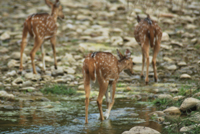Opening of core areas in wildlife parks to tourists
 Speaking at the ‘Billy Arjan Singh Memorial Convention’, organised by NGO Tiger and Terrain on the noted wildlife enthusiast’s first death anniversary here, Salman Khurshid, Union Minister for Corporate and Minority Affairs said that opening of core areas to tourists would go a long way in curbing poaching.
Speaking at the ‘Billy Arjan Singh Memorial Convention’, organised by NGO Tiger and Terrain on the noted wildlife enthusiast’s first death anniversary here, Salman Khurshid, Union Minister for Corporate and Minority Affairs said that opening of core areas to tourists would go a long way in curbing poaching.
He, however, noted that “entry to core areas must be strictly regulated and some criterion need to be laid down to allow such entry”. With the present system prevalent in some of the forests like Kaziranga where one can only notice uncontrolled and over tourism which is destroying the park in the non core, the case of regulated tourism must be first ensured.
Wildlife enthusiasts at the convention earlier sought to draw the minister’s attention to the fact that the core areas of wildlife parks and sanctuaries had turned into the safe haven for poachers. Some experts believe that poaching although being a great cause of concern, one should not dilute the issue of industrial pollution hazards that have endangered many animal species.
“Since there were not enough functionaries and those too inadequately equipped, core areas remained unfrequented even by the staff, with the result that poacher gangs could easily slip in and carry out their nefarious activities,” Tiger and Terrain secretary Kaushlendra Singh said. His views found favour with the minister, who is himself a wildlife enthusiast.
Ranjit Bhargava, who has been honoured with Padmashri for his wildlife conservation work, stressed on the need for diversion of a rail track and a highway from a 25 km stretch of Uttar Pradesh’s Dudhwa National Park, the second largest wildlife reserve after the world famous Corbett Park in Uttarakhand in north India. Same is in the case of Kaziranga where the National Highway is too close to the Park area and too much of non obeying traffic is certainly disturbing habitats at the Park.
Former Uttar Pradesh chief conservator of forests Gian Chand Misra expressed deep concern over the dwindling numbers of deer, which is the favoured food of tigers.
Most speakers felt that the official tiger count was “highly inflated”. However, Misra was of the view that fudging of tiger figures would come to an end once the modern counting system based on DNA match is introduced in all the parks. Think of this years report on tiger density by an NGO at Kaziranga, a whooping level of 32.64 per 100 sq. km. to Kaziranga with Corbett being the 2nd in the world with 19.2, well from where did the number rose so much. At least the locals in Kaziranga doesn’t seems to be impressed with the figures. The argument of “One of the key reasons for the high tiger density in Kaziranga is an abundance of prey animals including hog deer, sambar, swamp deer and wild buffalo.” is not acceptable enough as everybody knows that by eating more tiger does not produces more cubs at least. So, did they migrated from any other forest? From where then? there is no such forest area which is contagious to Kaziranga? Many questions answered.
Recent Entries
- New advance Rail ticket booking period reduced to 2 months from today
- Amarnath registration to start on March 18th
- Big Bird Day 2013
- Tour core tiger areas but don’t build: Supreme Court
- Interim ban on tourist activities in core areas of Project Tiger forests
- Tadoba on Red Alert
- The forgotten Silk Route – Jelep La
- National Park Status for Jaldapara
- Bouddha Bihar discovered at Dantan
- Melanistic Leopard Cat